August 16, 2004
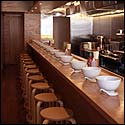
Openings
Using His Noodle
Before he opened Momofuku Noodle Bar, David Chang spent months cooking and eating in Japan, where he learned that ramen is as diverse as American barbecue, and that variations are just as passionately debated among connoisseurs. So rather than attempt the impossible—making “real ramen” far from its authentic Japanese context—he’s come up with his own style, using ingredients like miso compound butter, eggs slowly poached in their shells, Greenmarket corn, and Berkshire pork. The result is a gently priced menu rooted in tradition but not enslaved by it, with a Pan-Asian twist in the form of additions like cold Korean buckwheat noodles and Chinese pork buns.
163 First Avenue
212-475-7899
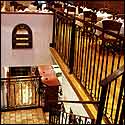
To New Heights
Slowly but surely, the owners of Jackson Heights’ popular Indian Taj have branched out, to Greenwich Village and on Long Island. Darbar, their latest and most elegant venture, occupies the east-midtown duplex recently vacated by D’Artagnan, and foie gras fanatics still in mourning can take some measure of comfort in Darbar’s thoughtful, hospitable service and extensive menu (not to mention its $9.95 lunch buffet). In addition to standard korma and tandoori preparations, the kitchen experiments with fusion fare like “trans-ethnic” Maine crab cakes and Indian-spiced potato croquettes stuffed with goat cheese—both of which can be paired with trans-ethnic drinks like Taj Mahal beer and North Fork Chardonnay.
152 East 46th Street
212-681-4500
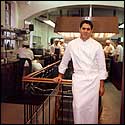
Kitchen Cru
Shea Gallante (pictured) used to be chef de cuisine at Bouley, and like his mentor, he’s been touched by the avant-garde spirit of Spain’s Ferran Adrià (among other forward-cooking Europeans). That explains the ethereal presence of hazelnut essence and evaporated-red-wine jus on the menu at Cru, the wine-centric recreation of the old Washington Park space. For the most part, though, the food is more mainstream modern than mad scientist: There’s “liver and onions” starring caramelized foie gras; spaghetti alla chitarra with zucchini and their blossoms; and quail served with its own soft-poached egg. Pastry chef Will Goldfarb improvises a nightly “spontaneous dessert,” and sommelier-about-town Robert Bohr has set a lofty goal for himself—to amass the country’s finest and most extensive wine collection. With 65,000 bottles in house, he’s off to a roaring start.
24 Fifth Avenue
212-529-1700
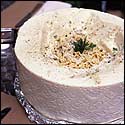
The Underground Gourmet
Pepper Mill
A terrific new Roman-inspired trattoria doesn’t stint on the spice.
In Cooking the Roman Way, David Downie writes that all it took to keep Attila the Hun from plundering Rome was a hefty ransom of peppercorns. No doubt Attila knew what he was doing, but had it been the Underground Gourmet on the warpath, he would have held out for a plate of tonnarelli cacio e pepe, the famous Roman dish of fresh square-shaped spaghetti tossed with sharp grated pecorino and heaps of black pepper. The owners of Cacio e Pepe, a new East Village trattoria, must feel the same way—they named their restaurant after it. Chef-partner Salvatore Corea’s rendition, presented theatrically in a 25-pound hollowed wheel of Pecorino Romano, is indeed delicious, as are the rest of the pastas on his menu. Co-owner Alessandro Peluso, a Roman through and through despite his trucker cap, sets the proudly regional tone, making minor allowances for the appetite of a third, Sicilian partner with a creditable bucatini con sarde. To Corea’s credit, the menu dares to be different (a necessity in the Italian-saturated East Village), sometimes strikingly so: grilled shrimp are wrapped in strips of lardo and served with puréed cannellini beans; mussels are skewered and served over artichoke hearts; monkfish substitutes for veal in the saltimbocca; and dessert strudel is filled with tomatillos and served with sweet basil sorbet. But it’s the exceptional pastas that make the strongest impression, along with the abundantly friendly service and homey vibe. —Rob Patronite
182 Second Avenue
212-505-5931
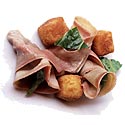
Object of Desire
Don’t Hold the Mayo
At WD-50, Wylie Dufresne has already paid tribute to Katz’s in the form of his signature corned duck with rye-crisp appetizer. Now comes a wink and nod to the 2nd Avenue Deli, perhaps, with his latest brainstorm: prosciutto-thin slices of calf’s tongue accessorized with a schmear of tomato “molasses” and “fried mayonnaise.” The latter—crisp, delicious, bread-crumbed-and-deep-fried nuggets of hot mayo—may not be kosher with deli mavens, but they certainly elicit the patented how’d-he-do-it? response.
50 Clinton Street
212-477-2900
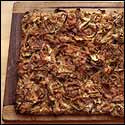
Shopping
Flour Power
Over the last decade, Sullivan Street Bakery has become a New York institution, its charred, chewy pugliese loaves found in countless restaurant bread baskets and its ciabatta and pizza bianca deliciously complicit in the recent panini proliferation. This summer, the bakery has gone 100 percent organic for its entire product line—including the superb new fennel-and-Parmesan pizza (pictured).
For store locations, see sullivanstreetbakery.com

Ask Gael
How romantic can it be?
It doesn’t get more romantic than Kittichai: two soot-defying gazebos out front, a lounge where petals float in jars, and a shadowy dining room with tea lights adrift on a shimmering pool. Ian Chalermkittichai gave up his reign as the first-ever Thai executive chef at the Bangkok Four Seasons to woo New York with stylish Thai fusion in this intimate silk-wrapped lair by the Rockwell team. Cocoa-dusted ribs that didn’t work on first tasting definitely do now. The kitchen remains uneven, but I’ll be back for short-rib curry, braised black cod in lime-coriander broth, Chilean sea bass with morning glory, and rare honey-glazed duck. In a small threat to romance, the servers in their tropical pajamas may look sexier than thou. And why do they insist everything is to share? (Spice Market does it, too.) Two shrimp in a citrus salad or three nests of seviche divvy into a mess at a table for four. Still, sensuality ultimately triumphs with dessert—luscious smoked coconut-milk tapioca with passion-fruit sorbet, and the stunningly devilish frozen chocolate cake with spicy pineapple chutney.
60 Thompson Street
212-219-2000